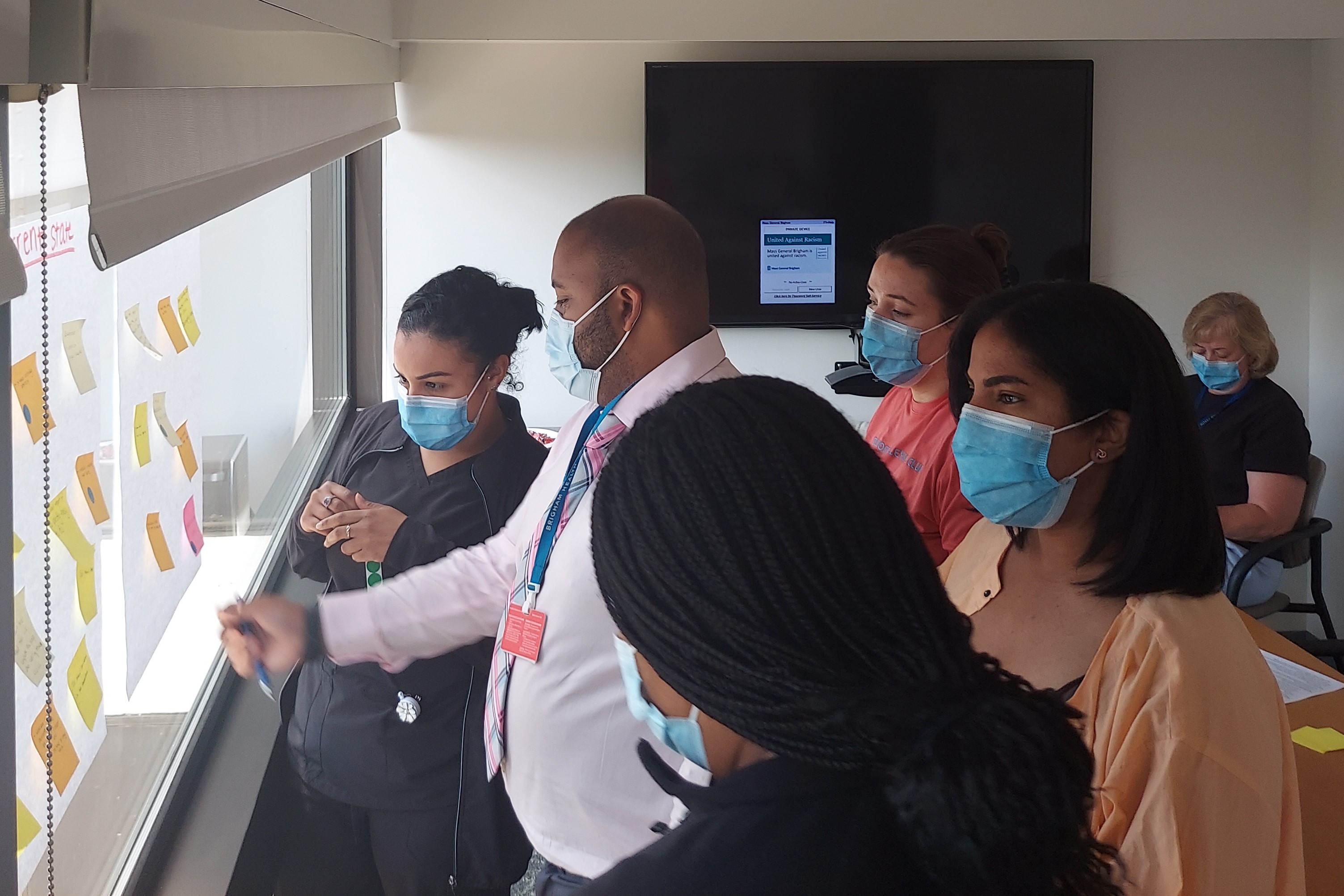Notice of privacy incident at Brigham and Women's Faulkner Hospital Learn More
Header Skipped.
Notice of privacy incident at Brigham and Women's Faulkner Hospital Learn More
Header Skipped.

Teams from both Radiology and the Orthopaedic Center meet to brainstorm solutions to improve their patients’ experience.
On the fifth floor at Brigham and Women’s Faulkner Hospital, patients will find both the Brigham and Women’s Orthopaedic Center and Radiology. The setup was designed to give orthopaedic patients easy access to the Xray imaging they need before meeting with their providers in orthopaedics. However, the process is not always perfect, and concerns have been expressed about missing or incorrect orders that result in delays in the Xray process as well as frustration for both patients and staff.
“We had been working with our colleagues in orthopaedics for a long time on ways to improve the experience for patients who go through the Xray process. Some of the interventions we have put in place include a portable Xray machine and extra staff on hand in our department,” says Brian McIntosh, BS, RT(R), CRA, Director of Radiology. “But one thing we had never really looked at was the accuracy of the orders themselves and whether or not that was creating some efficiency issues upon check-in.”
When a patient presents at the front desk in Xray and it’s discovered that they either do not have an order for an Xray or the order they do have is incorrect, the front desk staff needs to do some research to correct the problem in order to prevent a patient safety or billing issue. That research involves calls back and forth to the Orthopaedic Center, which can cause delays for the patient.
McIntosh and his team decided to explore the issue as part of their annual Quality Assurance Process Improvement (QAPI) plan. “I knew it was not something that we could solve on our own,” says McIntosh. “It would require a true collaboration between Radiology and the Orthopaedics Center.”
To facilitate that collaboration, McIntosh enlisted the help of the Performance Improvement team who brought together the key stakeholders, including front desk and clinical staff, from both areas to investigate where in the process issues start and brainstorm ways to mitigate the risk of those issues arising.
“One of the things we first looked at was systems to discover the root causes. With all the key stakeholders in the room, we put everything on the board so that we could visualize the steps that it takes to create an Xray order and where there were potential risks for missing or incorrect orders to occur,” explains Aaron Barbour, Operations Supervisor for the Department of Orthopedic Surgery and Comprehensive Spine Center.
Upon reviewing the process, the team found two areas where there was risk for a missing or incorrect order: during intake in the call center and upon chart preparation by medical assistants in the Orthopaedic Center. When reviewing call center recordings, they found instances where the patient said one thing and the staff doing the intake mistakenly wrote down the wrong information, resulting in an incorrect order. Similar human error was seen in the chart preparation process.
To mitigate the risk, the team has developed a new system for double-checking orders before the patient arrives for their Xray. In addition, they have made strides to improve communications when an issue does occur by providing the Xray front desk staff daily contact information for orthopaedic providers so they can contact the provider directly when there is an issue rather than be routed through the front desk in the Orthopaedic Center.
Performance Improvement intern Udochi Emeghara has been tracking data in these early phases and says it looks promising. “We haven’t officially begun analyzing the data, but it seems to me call volume between the departments is going down. That leads me to believe there are fewer issues with missing or incorrect orders that need to be investigated,” she says.
Both McIntosh and Barbour agree that the initial results are promising, but want to track performance over the long-term to ensure sustained improvement in their patients’ experience as well as their staff’s workflow.
Regardless, the biggest win in the project has been the collaboration between the two departments. “I have been involved in several performance improvement projects over the years,” says McIntosh. “I am so impressed with the level of collaboration between these two departments. It has far exceeded my expectations. It’s been wonderful.”
For his part, Barbour is also pleased. “Our departments are intertwined. It’s beneficial for both departments to research some of the efficiency issues that we have and work together to improve the patient experience.”
Has your department identified a process or workflow that could benefit from the performance improvement process? To learn more about performance improvement and the services available here at BWFH, visit BWFHconnect.
Published 7/13/22
Looking for more news from BWFH? Go to News to find articles about health, updates to our programs and services and stories about staff and patients.
Go to News